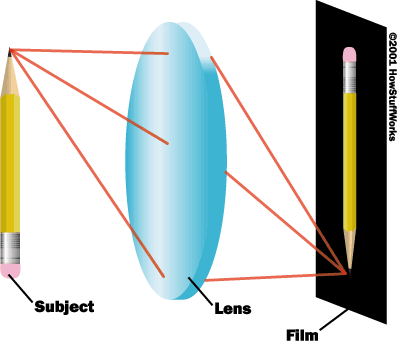The
Focal Plane
Another
important aspect of imaging is to understand how the image
is prepared for exposure onto a piece of film or a digital
CCD chip. This is typically done through the utilization
of a glass lens system. A simple illustration of such
a system can be seen below in figure one.
Figure
One (Typical glass lens system with the representation
of a focal point)

(image
courtesy of http://home.att.net/~w.bed/light-VIII.htm)
From
figure one it is apparent that the incoming light rays
that hit the lens are bent (refracted) inside the lens
and that the rays are all focused at one single point.
This point marks the posistion of the focal plane. Essentially,
if the lens were pointed at an object, then the object
would appear on a flat plane made up of an infinite number
of focal points within that plane (i.e. a dicernable image).
These numerous focal points come from the fact that the
object is not a pinpoint, but rather spread over a region
of the lens' field of view. This can be seen more clearly
in figure two below.
Figure
Two (Lens with entire focal plane being representend)

(image
courtesy of howstuffworks.com)
Furthermore,
another more familiar example of this can be seen by clicking
here.
From
figure two and the satellite dish example, it can be seen
that the object infront of the lens is displayed with
great sharpness and clarity upon the focal plane. From
this, it should become apparent that all that is needed
to obtain an image is to place the photosensitive material
(film or CCD) at the posistion of this focal plane, and
the image would then successfully be recorded.
Another
important aspect of this focal plane, as mentioned previously,
is that it is formed from an infinite number of focal
points. This brings up a very important goal in imaging
technology; to make a type of sensor with an infinite
number of "light wave recording" zones. Of course,
this infinite ideal is impossible in the real world, however,
a very large finite number of light recording zones can
be created on a given surface area. The number of these
recording zones on a particular piece of film or CCD is
typically referred to as its resolution. The higher
the number of recording zones, the higher the resolution
and the higher quality the recorded image will be. In
the case of CCD's, these recording regions are called
pixels and in the case of film, they are typically
referred to as its crystal density (however, a crystal
is directly analogues to a pixel).
Each
one of these recording zones "saves" a portion
of the type of light that hits it. To see how this information
is saved for both film or CCD's, check out the next two
sections about CCD's and Film.

